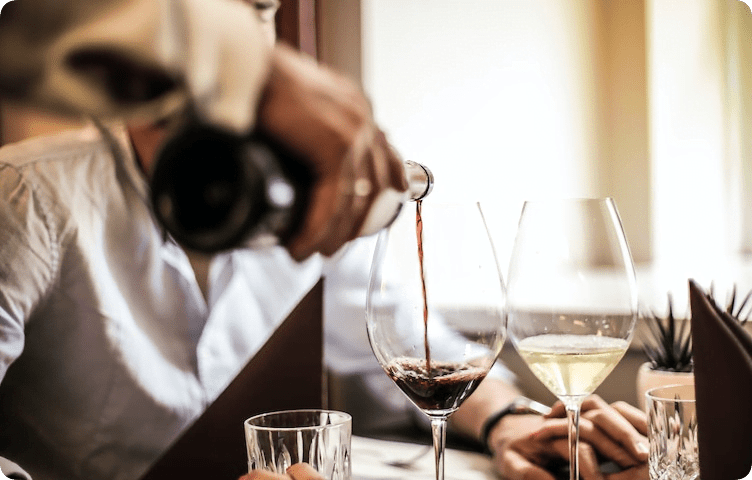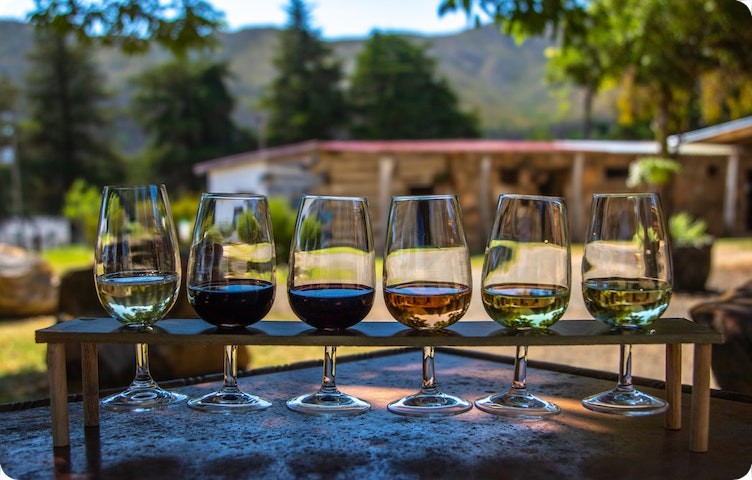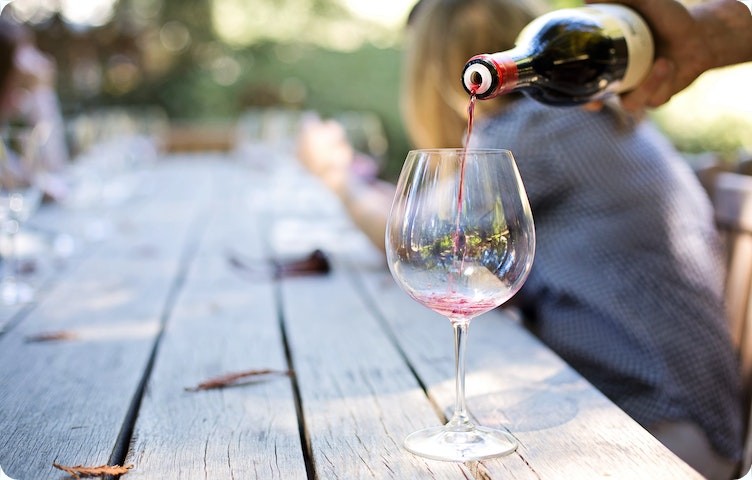Drinking wine for pleasure and tasting it to determine its quality are two different things. For proper tasting, you need to create a suitable environment, acquire special utensils, and study the rules. Do you want to evaluate noble alcohol like a professional? Follow the tips in this article and you'll quickly master the basic skills of a wine expert!
Ideal environment for tasting
The circumstances under which you taste a drink directly affect how it tastes. Noise in the room, too many people around - all this makes it difficult to concentrate. The smells of perfumes, food, and flowers negatively affect the sense of smell.
Here are five conditions necessary for proper tasting:
a table covered with a white tablecloth or paper - the white color helps to more accurately assess the appearance of the drink;
good lighting - natural daylight or neutral electric lamps are suitable;
absence of foreign odors - the room must be pre-ventilated;
temperature – red wine should be cooled to +12-18° C, white or rose – to +7-10° C;
glassware – traditionally, tasters use transparent glasses made of lead-free glass, the shape of which matches the type of product.
If not all conditions are met, try to improve them. A drink that is too cold can be warmed by grasping the glass with both hands. If the vessel does not seem clean enough, condition it - rinse with wine so as to cover the entire cup. If there are a lot of foreign odors in the room, especially perfume, move away from their sources.
The right glasses for tasting

The taste of the drink can be changed for the worse if it is served in an improperly shaped container. Traditionally, red wine is poured into glasses with a massive bowl and a wide neck. Under such conditions, wine tannins soften faster and the aroma develops. For white and rosé wines, medium-sized wine glasses with a narrow rim are more suitable, making it easier for the liquid to reach the tip of the tongue.
Sparkling wines are served in flute glasses with a narrow conical bowl. This cookware keeps carbon dioxide bubbles and the contents at a low temperature longer.
Fortified alcohol such as port wine, Madeira, sherry is tasted from tall glasses with a small bowl.
But most wine experts use the same glassware to evaluate different drinks.
This is a special ISO glass with a round bowl and slightly tapering walls. Its shape makes it easy to aerate and shake the contents. The product is available in different sizes - from 120 to 410 ml.
Recommended varieties for first tastings

Experienced sommeliers and winemakers advise starting with white wines, as their taste is easier to perceive. Light varieties with fruity aromas are suitable for starting - Chardonnay, Sauvignon Blanc, Riesling . A pleasant sour taste with notes of berries, citrus and tropical fruits will help you get used to the wine and begin to recognize its characteristics.
Among the red varieties , Pinot Noir, Syro, and Merlot are recommended. They have a relatively simple taste with hints of ripe fruit and spices.
Basic rules for tasting
The examination of wines is carried out on the basis of three criteria - appearance, aroma, taste. Having examined these factors, the taster draws a conclusion and makes a conclusion about the quality of the drink.
It is important to follow the basic rules:
- Avoid eating foods with intense tastes and odors. Two hours before the tasting, you should not drink coffee or eat hot or spicy foods. Ladies should give up lipstick during this time.
- Come to the tasting feeling normal. A cold with nasal congestion makes it difficult to smell the aroma. Taking many medications impairs the functioning of taste buds.
- Avoid strong-smelling cosmetics. Perfume, eau de toilette and lotions impair the sense of smell.
- Do not smoke two hours before the examination. Smoking itself does not affect the perception of aromas, but the smell of tobacco from clothes and hair will interfere with other tasters.
- Remain silent during the procedure. Talking will make it difficult for you and other experts to concentrate.
Human senses operate differently, so we perceive tastes and aromas differently.
The main thing is to trust your feelings and respect the opinions of other tasters.
Color saturation

First of all, the appearance of the sample is assessed. Wine is poured to about a third of the glass's volume. First they examine it, looking straight ahead, then - against the light and, finally, tilt the wine glass so that the liquid flows to the edges. These actions allow you to see the entire color spectrum of the wine.
Looking from above helps determine the depth of color, density and saturation of the product. From the side, transparency and the presence of impurities are assessed. By tilting the glass, experts determine the age of the drink. Pale color and watery texture around the edges indicate a weakly expressed taste. A yellowish-brown hue in white varieties and a brick-rusty hue in red varieties indicates excessive oxidation, which is common in old or spoiled wines.
Then the glass standing on the table is twisted by the stem. An aged product with a high content of alcohol and glycerin leaves “tears” or streaks on the walls of the dishes.
Aroma
Having completed the visual assessment of the wine, it is necessary to study the aroma. To do this, you need to twist and smell the glass. There is no need to bring the glass close to your nose, just take a few quick breaths over its neck. Then the glass is moved away to understand the nuances of the aroma. First, the main elements of the smell are recognized - fruity, herbal, floral notes. With practice comes an understanding of secondary and tertiary aromas, such as nut shells, spices, wood.
Foreign odors indicate the shortcomings of the product:
- burnt matches - the presence of sulfur oxide in the composition;
- vinegar – increased acidity;
- sweat – excess yeast;
- a musty room means spoiled wine.
A good wine smells of fresh fruit, especially if the variety is not very sweet. White varieties usually smell of flowers, while red varieties contain notes of wild herbs, mushrooms, and wet earth. Aromas of vanilla, chocolate, coffee, smoke, roasted nuts and caramel indicate aging in new oak barrels.
Flavor and texture
The assessment begins with one small sip. Suck the liquid slowly, as if drinking through a straw. This will help oxygenate the sample and distribute it throughout the mouth. Experienced tasters identify four types of wine based on their taste:
balanced – includes the main taste components (sweetness, bitterness, acidity, saltiness). A good wine is dominated by sweetness, which comes from residual sugar, and acidity. Bitterness is felt as a tart taste of tannins. Salty notes are less common. There is no single balance formula for all wines, but an experienced taster will easily detect excessive pungency, astringency or cloying;
harmonious – represents an organic combination of flavor shades;
complex – combines simple flavors of fruit and vanilla with subtle notes of herbs, spices, and minerals. Complex wines reveal their properties gradually, subtly changing as they drink;
complete – this is the name given to a product with a complex, harmonious taste and a pleasant, long aftertaste.
If the wine leaves a warm feeling in your mouth, it means it has a high percentage of alcohol. Drinks with this property are made from grapes grown in warm climates.
How long does it take to learn how to evaluate wine?
Research shows that only 15% of people naturally have the ability to distinguish the subtle nuances of taste and aroma. But feelings can be trained with practice. To do this, you need to regularly organize home tastings, recording the sensations from each sample. Thus, basic skills are mastered in 2-3 months. Attending master classes by famous sommeliers helps speed up the process. If you want to get professional training, you should take a taster course.
We also recommend reading the book “Taste ”. In which he talks in great detail and interestingly about taste from the perspective of a person’s senses. A must have for aspiring sommeliers, bartenders, chefs and simply those who are developing a culture for themselves.
















































/https%3A%2F%2Fcomplexbar.com%2Fimages%2Fblog%2F244%2Fdegustacia-vin.jpg)
/https%3A%2F%2Fcomplexbar.com%2Fimages%2Fblog%2F246%2Fsirop_scale_2400.jpeg)
/https%3A%2F%2Fcomplexbar.com%2Fimages%2Fblog%2F246%2Fkofe-vostochniy.jpg)
/https%3A%2F%2Fcomplexbar.com%2Fimages%2Fblog%2F245%2Fpexels-jason-villanueva-851555.jpg)
/https%3A%2F%2Fcomplexbar.com%2Fimages%2Fblog%2F246%2F2024-04-09_17.22.54.jpg)
/https%3A%2F%2Fcomplexbar.com%2Fimages%2Fblog%2F246%2F2024-04-09_17.22.47.jpg)
/https%3A%2F%2Fcomplexbar.com%2Fimages%2Fblog%2F246%2FCODE_anons_foamydrops_752%D1%85480_eng.jpg)
/https%3A%2F%2Fcomplexbar.com%2Fimages%2Fblog%2F246%2FAlina_752%D1%85480_eng.jpg)
/https%3A%2F%2Fcomplexbar.com%2Fimages%2Fblog%2F246%2F2024-04-09_17.23.22.jpg)
/https%3A%2F%2Fcomplexbar.com%2Fimages%2Fblog%2F246%2F2024-04-09_17.23.28.jpg)
/https%3A%2F%2Fcomplexbar.com%2Fimages%2Fblog%2F246%2F2024-04-09_17.23.35.jpg)
/https%3A%2F%2Fcomplexbar.com%2Fimages%2Fblog%2F246%2Fdrinksome_752%D1%85480_eng.jpg)
/https%3A%2F%2Fcomplexbar.com%2Fimages%2Fblog%2F246%2Fnude_752%D1%85480_eng.jpg)
/https%3A%2F%2Fcomplexbar.com%2Fimages%2Fblog%2F246%2F752%D1%85480_eng__1_.jpg)
/https%3A%2F%2Fcomplexbar.com%2Fimages%2Fblog%2F246%2F752%D1%85480_eng.jpg)
/https%3A%2F%2Fcomplexbar.com%2Fimages%2Fblog%2F246%2FStudioRaw_752%D1%85480_eng.jpg)
/https%3A%2F%2Fcomplexbar.com%2Fimages%2Fblog%2F246%2FDoppio_tea_752%D1%85480_eng.jpg)
/https%3A%2F%2Fcomplexbar.com%2Fimages%2Fblog%2F246%2FTognana_Stars_Stripes_752%D1%85480_eng.jpg)
/https%3A%2F%2Fcomplexbar.com%2Fimages%2Fblog%2F246%2FRona_752%D1%85480_eng.jpg)
/https%3A%2F%2Fcomplexbar.com%2Fimages%2Fblog%2F246%2FDoppio_vending_752%D1%85480_eng.jpg)
/https%3A%2F%2Fcomplexbar.com%2Fimages%2Fblog%2F246%2FEssence_sukhie_smesi_752%D1%85480_eng.jpg)
/https%3A%2F%2Fcomplexbar.com%2Fimages%2Fblog%2F246%2FODK_sukhie_smesi752%D1%85480_eng.jpg)
/https%3A%2F%2Fcomplexbar.com%2Fimages%2Fblog%2F246%2Funiforma-barmena.jpg)
/https%3A%2F%2Fcomplexbar.com%2Fimages%2Fblog%2F246%2Fkak-nanyat-barmena.jpg)
/https%3A%2F%2Fcomplexbar.com%2Fimages%2Fblog%2F246%2Fsirop_scale_2400.jpeg)
/https%3A%2F%2Fcomplexbar.com%2Fimages%2Fblog%2F246%2FPeugeot_Anons_Paris_U%27Select_Line_Daman_752%D1%85480_eng.jpg)
/https%3A%2F%2Fcomplexbar.com%2Fimages%2Fblog%2F246%2Fkofe-vostochniy.jpg)
/https%3A%2F%2Fcomplexbar.com%2Fimages%2Fblog%2F246%2FMadler.jpg)
/https%3A%2F%2Fcomplexbar.com%2Fimages%2Fblog%2F246%2Fprofbartender_glavn.jpeg)